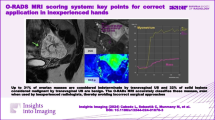Abstract
Objectives
To analyse the diagnostic accuracy and to establish a predictive score based on diffusion-weighted magnetic resonance imaging (DWMRI) compared to exploratory laparotomy (EL) for predicting suboptimal cytoreductive surgery for different intra-abdominal sites of implants in patients with ovarian cancer.
Methods
Thirty-four patients with advanced ovarian carcinoma were studied. Preoperative DWMRI of the abdomen and pelvis was performed. DWMRI findings were compared with EL. Ten anatomical sites were selected for inclusion in the score. Sensitivity, specificity, positive predictive value, negative predictive value and accuracy for suboptimal cytoreduction were calculated for both DWMRI and EL. Receiver operating characteristic (ROC) curve analysis was used to assess the ability to predict suboptimal cytoreduction.
Results
Using predictive score, ROC curves were generated with an area under the curve of 0.938 for DWMRI and 0.947 for EL (P < 0.0001). For DWMRI, a score ≥6 had the highest overall accuracy at 91.1 % and identified patients with unnecessary EL with a sensitivity of 75 %. For EL, a score ≥4 had the highest overall accuracy at 88.2 % and was able to identify patients with unnecessary EL with a sensitivity of 87.5 %.
Conclusions
DWMRI is an emerging technique that may be useful to predict suboptimal cytoreduction in ovarian cancer.
Key Points
• DWMRI is increasingly used in ovarian cancer.
• DWMRI is an accurate technique for depicting intra-abdominal sites of implants
• DWMRI is useful for predicting optimal cytoreductive surgical outcome.
• We report a high predictive value similar to exploratory laparotomy.



Similar content being viewed by others
References
Angioli R, Palaia I, Zullo MA et al (2006) Diagnostic open laparoscopy in the management of advanced ovarian cancer. Gynecol Oncol 100:455–461
Testa AC, Ludovisi M, Mascilini F et al (2012) Ultrasound evaluation of intra-abdominal sites of disease to predict likelihood of suboptimal cytoreduction in advanced ovarian cancer: a prospective study. Ultrasound Obstet Gynecol 39:99–105
Vergote I, Trope GC, Amant F et al (2010) Neoadjuvant chemotherapy or primary surgery in stage IIIC or IV ovarian cancer. N Engl J Med 363:943–953
Chi DS, Zivanovic O, Palayekar MJ et al (2009) A contemporary analysis of the ability of preoperative serum CA125 to predict primary cytoreductive outcome in patients with advanced ovarian, tubal and peritoneal carcinoma. Gynecol Oncol 112:6–10
Ferrandina G, Sallustio G, Fagotti A et al (2009) Role of CT scan-based and clinical evaluation in the preoperative prediction of optimal cytoreduction in advanced ovarian cancer: a prospective trial. Br J Cancer 101:1066–1073
Fagotti A, Ferrandina G, Fanfani F et al (2008) Prospective validation of a laparoscopic predictive model for optimal cytoreduction in advanced ovarian carcinoma. Am J Obstet Gynecol 199:642.e1–642.e6
Brun JL, Rouzier R, Uzan S, Daraï E (2008) External validation of a laparoscopic-based score to evaluate resectability of advanced ovarian cancers: clues for a simplified score. Gynecol Oncol 110:354–359
Bristow RE, Duska LR, Lambrou NC et al (2000) A model for predicting surgical outcome in patients with advanced ovarian carcinoma using computed tomography. Cancer 89:1532–1540
Namimoto T, Awai K, Nakaura T, Yanaga Y, Hirai T, Yamashita Y (2009) Role of diffusion-weighted imaging in the diagnosis of gynecological diseases. Eur Radiol 19:745–760
Sala E, Kataoka MY, Priest AN et al (2012) Advanced ovarian cancer: multiparametric MR imaging demonstrates response- and metastasis-specific effects. Radiology 263:149–159
Low RN, Sebrechts CP, Barone RM, Muller W (2009) Diffusion-weighted MRI of peritoneal tumors: comparison with conventional MRI and surgical and histopathologic findings—a feasibility study. AJR Am J Roentgenol 193:461–470
Hoskins WJ (1994) Epithelial ovarian carcinoma: principles of primary surgery. Gynecol Oncol 55:S91–S96
Heintz APM, Hacker NF, Berek JS, Rose TP, Munoz AK, Lagasse LD (1986) Cytoreductive surgery in ovarian carcinoma: feasibility and morbidity. Obstet Gynecol 67:783–788
Farias-Eisner R, Teng F, Oliveira M et al (1994) The influence of tumor grade, distribution, and extent of carcinomatosis in minimal residual stage III epithelial ovarian cancer after optimal primary cytoreductive surgery. Gynecol Oncol 55:108–110
Chi DS, Venkatraman ES, Masson V, Hoskins WJ (2000) The ability of preoperative CA125 to predict optimal primary tumor cytoreduction in Stage III epithelial ovarian carcinoma. Gynecol Oncol 77:227–231
Hanley JA, McNeil BJ (1982) The meaning and use of the area under a Receiver Operating Characteristic (ROC) curve. Radiology 143:29–36
Golde JH, Coldman AJ (1979) A mathematical model for relating the drug sensitivity of tumors to the spontaneous mutation rate. Cancer Treat Rep 63:1727–1733
Hou JY, Kelly MG, Yu H et al (2007) Neoadjuvant chemotherapy lessens surgical morbidity in advanced ovarian cancer and leads to improved survival in stage IV disease. Gynecol Oncol 105:211–217
Brockbank E, Ind T, Barton D et al (2004) Preoperative predictors of suboptimal primary surgical cytoreduction in women with clinical evidence of advanced primary epithelial ovarian cancer. Int J Gynecol Cancer 14:42–50
Memarzadeh S, Lee S, Berek J, Farias-Esner R (2002) Ca125 levels are a weak predictor of optimal cytoreductive surgery in patients with advanced epithelial ovarian cancer. Obstet Gynecol 100:59–64
Fujii S, Matsusue E, Kanasaki Y et al (2008) Detection of peritoneal dissemination in gynecological malignancy: evaluation by diffusion-weighted MR imaging. Eur Radiol 18:18–23
Low RN, Barone RM. Combined diffusion-weighted and gadolinium-enhanced MRI can accurately predict the peritoneal cancer index preoperatively in patients being considered for cytoreductive surgical procedures. Ann Surg Oncol 19:1394–1401.
Coakley FV, Choi PH, Gougoutas CA et al (2002) Peritoneal metastases: detection with spiral CT in patients with ovarian cancer. Radiology 223:495–499
Hamrick-Turner JE, Chiechi MV, Abbitt PL, Ros PR (1992) Neoplastic and inflammatory processes of the peritoneum, omentum, and mesentery: diagnosis with CT. Radiographics 12:1051–1068
Kawamoto S, Urban BA, Fishman EK (1999) CT of epithelial ovarian tumors. Radiographics 19:S85–S102
Author information
Authors and Affiliations
Corresponding author
Rights and permissions
About this article
Cite this article
Espada, M., Garcia-Flores, J.R., Jimenez, M. et al. Diffusion-weighted magnetic resonance imaging evaluation of intra-abdominal sites of implants to predict likelihood of suboptimal cytoreductive surgery in patients with ovarian carcinoma. Eur Radiol 23, 2636–2642 (2013). https://doi.org/10.1007/s00330-013-2837-7
Received:
Revised:
Accepted:
Published:
Issue Date:
DOI: https://doi.org/10.1007/s00330-013-2837-7




